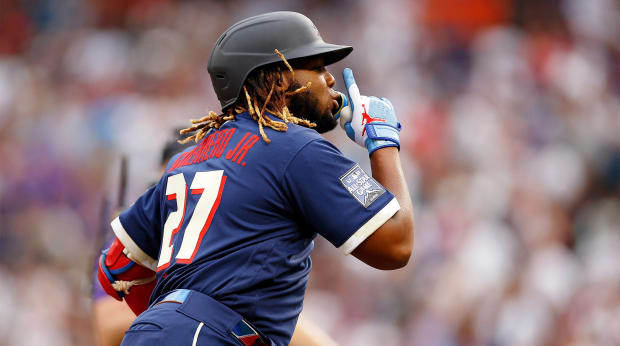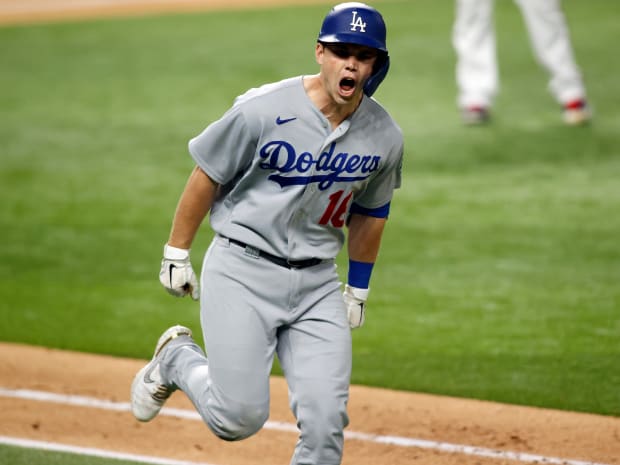Average hit rate can be a better metric than slugging percentage for fantasy managers.
After finishing the research for all 30 teams for the 2022 baseball season, I’ll swing back to the average hit rate stat I use for a reference to help determine the direction of a player in projecting home runs.
Slugging percentage has been the standard for many years in baseball to show a player’s power potential. Last year, the major-league average for slugging percentage was .411 (.415 in 2020, .435 in 2019 and .409 in 2018).

© Isaiah J. Downing/USA TODAY Sports
Vladimir Guerrero led the American League in home runs (48) in 2021. He finished with an impressive slugging percentage of .601. Does it give a good reference point for all players when looking at this stat? How many home runs should a player hit with a .400 or .500 slugging percentage?
Here are the 17 players who hit 35-plus home runs last season:

The range of these players in slugging percentage had a high of .615 (Bryce Harper) and a low of .485 (Mitch Haniger).
Average hit rate (AVH) = total bases divided by hits (singles + doubles x2 + triples x3 + home runs x4 divided by hits).
The above players had a floor of .189 in average hit rate. Shohei Ohtani posted the highest average hit rate (2.30).
Of the 84 players with a minimum of 500 at-bats last year, 32 had 30 or more home runs. Among those players, only Freddie Freeman (1.68) had an average hit rate under 1.75. Of those 32 players with 30 or more home runs and more than 500 at-bats, 12 players had a slugging percentage under .500.
To help understand my thought process when using this data in my player research, I’ll look at a couple of players to show how I use this data.
Coming through the Nationals’ system, Victor Robles hit .301 with 289 runs, 32 homers, 163 RBI and 136 stolen bases over 1,523 at-bats. He flashed over two levels of the minors in 2017 (.300/73/10/4727 over 430 at-bats) with strength in his slugging percentage (.493).
In his first entire season in the majors, Robles smashed 17 home runs over 546 at-bats with just below the league average in his slugging percentage (.419 – .435 in 2019). The following draft season, a fantasy owner would look at his output in power and expect his next step to be 20-plus home runs.
When looking at his average hit rate (1.647) in 2019, Robles looked to be getting stronger. Unfortunately, over his next 483 at-bats with the Nationals, he only hit .209 with 57 runs, five home runs, 34 RBI and 12 steals, with weakness in his average hit rate (1.446) and slugging percentage (.302). In this case, Robles has a better outlook in home runs by looking at his average hit rate than his slugging percentage.
Most will shy away from him after a couple of lousy seasons but chase him later in drafts due to his upside in steals. His average hit rate supports a push to 15 home runs while also having the talent to improve on his minor-league resume.
His ADP (513) in the early draft season in the National Fantasy Baseball Championship puts him in the free-agent pool in all redraft leagues. Therefore, Robles should be treated as a base stealer in waiting in deep formats. Robles will be an impact player for his price point if he adds more power to his stat line.
The growth in catcher Will Smith's approach drew more attention from fantasy managers this draft season, but he still has an undervalued feel based on his tremendous upside in home runs.
His slugging percentage in his first three seasons (.571, .579 and .495) with the Dodgers jumps off the page while only showcasing a slight edge in his minor-league career (.459).

Tim Heitman-USA TODAY Sports
In comparison, Smith has delivered strength in his average hit rate in 2017 (1.931), 2018 (1.951), 2019 (AAA – 2.225 and 2.256), 2020 (2.000) and 2021 (1.916) in the minors and majors, setting an impressive floor in home runs if given over 500 at-bats.
The casual fantasy manager may not know that Smith has a massive fly-ball swing path (48.5) in the majors, which is why he rates so highly in his average hit rate.
With the DH back in the National League, Smith should naturally pick up more playing time and his bat should drive his ceiling to an explosive level. His average hit rate paints a floor of 30 home runs with a push higher in runs and RBI. The fantasy love for him is real, but Smith still looks to be a value in drafts based on his ADP (57).
Average hit rate tells a pretty good story. In the ideal situation, we would like to see a player adding more length to his hits. Any player with an average hit rate of 1.75 or higher has 30-home run power with more than 550 at-bats. A Judy-type player (all speed and no power) will have an average hit rate under 1.35.
The goal here is to glance at a player's average hit rate and home run total to get a feel for a player's upside in power. Understanding each player’s ground-ball, fly-ball and hard-hit rate is also imperative. A change in swing path could lead to a massive jump in home runs.
Slugging percentage doesn’t tell the same story for me when studying baseball players. If a player has a slugging percentage over .500, it doesn’t necessarily mean that player is a 30-home run hitter.
Defining a player's direction in fantasy baseball is the key to a winning season. Ideally, a fantasy manager needs to identify a player with underlying metrics that point to a breakout season when added to a better opportunity in playing time or an improved slot in the batting order. Average hit rate is an essential tool for me and one I hope you incorporate into your research plan in the future.
More fantasy baseball coverage: